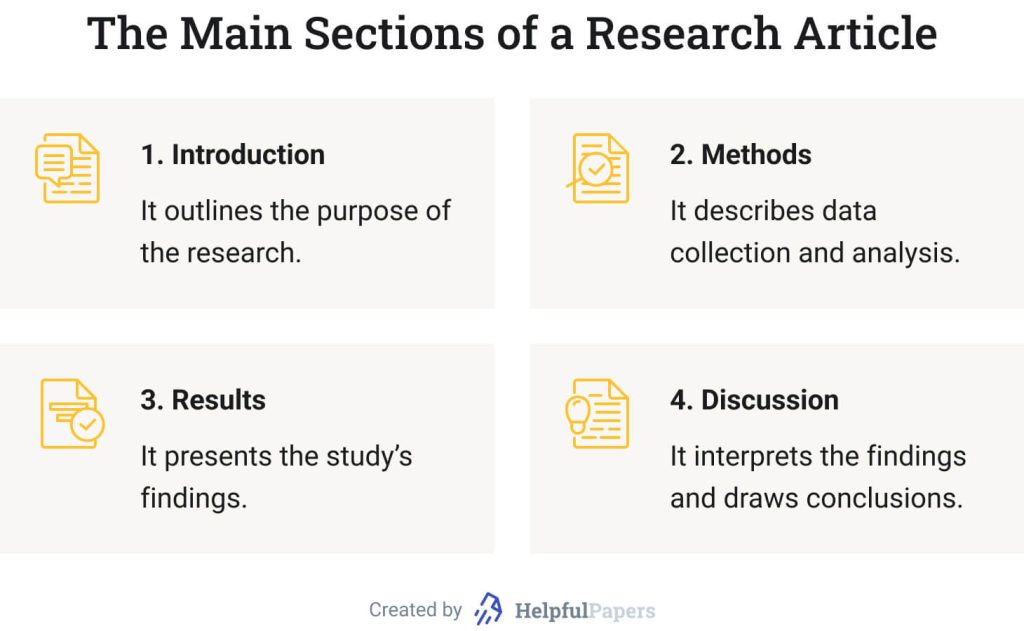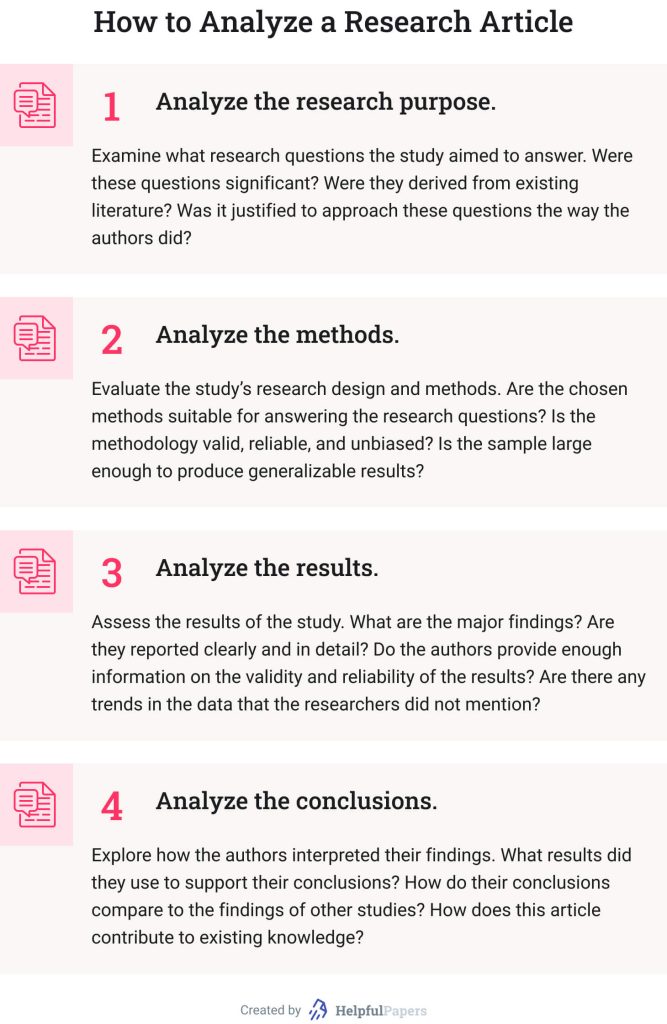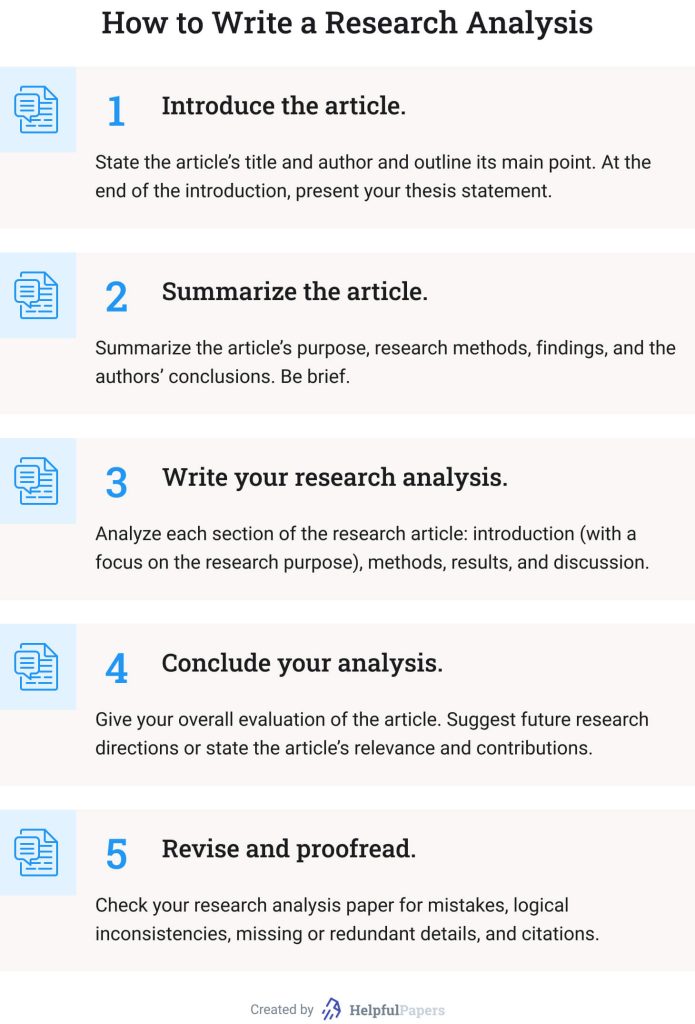Why might you need to analyze research? First of all, when you analyze a research article, you begin to understand your assigned reading better. It is also the first step toward learning how to write your own research articles and literature reviews. However, if you have never written a research paper before, it may be difficult for you to analyze one. After all, you may not know what criteria to use to evaluate it. But don’t panic! We will help you figure it out!
In this article, our team has explained how to analyze research papers quickly and effectively. At the end, you will also find a research analysis paper example to see how everything works in practice.
🔤 Research Paper Analysis: What Is It?
A research paper analysis is an academic writing assignment in which you analyze a scholarly article’s methodology, data, and findings. In essence, “to analyze” means to break something down into components and assess each of them individually and in relation to each other. The goal of an analysis is to gain a deeper understanding of a subject. So, when you analyze a research article, you dissect it into elements like data sources, research methods, and results and evaluate how they contribute to the study’s strengths and weaknesses.
📋 Research Analysis Format
A research analysis paper has a pretty straightforward structure. Check it out below!
📊 How to Analyze a Research Article
Research articles usually include the following sections: introduction, methods, results, and discussion. In the following paragraphs, we will discuss how to analyze a scientific article with a focus on each of its parts.

How to Analyze a Research Paper: Purpose
The purpose of the study is usually outlined in the introductory section of the article. Analyzing the research paper’s objectives is critical to establish the context for the rest of your analysis.
When analyzing the research aim, you should evaluate whether it was justified for the researchers to conduct the study. In other words, you should assess whether their research question was significant and whether it arose from existing literature on the topic.
Here are some questions that may help you analyze a research paper’s purpose:
- Why was the research carried out?
- What gaps does it try to fill, or what controversies to settle?
- How does the study contribute to its field?
- Do you agree with the author’s justification for approaching this particular question in this way?
How to Analyze a Paper: Methods
When analyzing the methodology section, you should indicate the study’s research design (qualitative, quantitative, or mixed) and methods used (for example, experiment, case study, correlational research, survey, etc.). After that, you should assess whether these methods suit the research purpose. In other words, do the chosen methods allow scholars to answer their research questions within the scope of their study?
For example, if scholars wanted to study US students’ average satisfaction with their higher education experience, they could conduct a quantitative survey. However, if they wanted to gain an in-depth understanding of the factors influencing US students’ satisfaction with higher education, qualitative interviews would be more appropriate.
When analyzing methods, you should also look at the research sample. Did the scholars use randomization to select study participants? Was the sample big enough for the results to be generalizable to a larger population?
You can also answer the following questions in your methodology analysis:
- Is the methodology valid? In other words, did the researchers use methods that accurately measure the variables of interest?
- Is the research methodology reliable? A research method is reliable if it can produce stable and consistent results under the same circumstances.
- Is the study biased in any way?
- What are the limitations of the chosen methodology?
How to Analyze Research Articles’ Results
You should start the analysis of the article results by carefully reading the tables, figures, and text. Check whether the findings correspond to the initial research purpose. See whether the results answered the author’s research questions or supported the hypotheses stated in the introduction.
To analyze the results section effectively, answer the following questions:
- What are the major findings of the study?
- Did the author present the results clearly and unambiguously?
- Are the findings statistically significant?
- Does the author provide sufficient information on the validity and reliability of the results?
- Have you noticed any trends or patterns in the data that the author did not mention?
How to Analyze Research: Discussion
Finally, you should analyze the authors’ interpretation of results and its connection with research objectives. Examine what conclusions the authors drew from their study and whether these conclusions answer the original question.
You should also pay attention to how the authors used findings to support their conclusions. For example, you can reflect on why their findings support that particular inference and not another one. Moreover, more than one conclusion can sometimes be made based on the same set of results. If that’s the case with your article, you should analyze whether the authors addressed other interpretations of their findings.
Here are some useful questions you can use to analyze the discussion section:
- What findings did the authors use to support their conclusions?
- How do the researchers’ conclusions compare to other studies’ findings?
- How does this study contribute to its field?
- What future research directions do the authors suggest?
- What additional insights can you share regarding this article? For example, do you agree with the results? What other questions could the researchers have answered?

✍️ How to Write a Research Analysis
Now, you know how to analyze an article that presents research findings. However, it’s just a part of the work you have to do to complete your paper. So, it’s time to learn how to write research analysis! Check out the steps below!
1. Introduce the Article
As with most academic assignments, you should start your research article analysis with an introduction. Here’s what it should include:
- The article’s publication details. Specify the title of the scholarly work you are analyzing, its authors, and publication date. Remember to enclose the article’s title in quotation marks and write it in title case.
- The article’s main point. State what the paper is about. What did the authors study, and what was their major finding?
- Your thesis statement. End your introduction with a strong claim summarizing your evaluation of the article. Consider briefly outlining the research paper’s strengths, weaknesses, and significance in your thesis.
Keep your introduction brief. Save the word count for the “meat” of your paper — that is, for the analysis.
2. Summarize the Article
Now, you should write a brief and focused summary of the scientific article. It should be shorter than your analysis section and contain all the relevant details about the research paper.
Here’s what you should include in your summary:
- The research purpose. Briefly explain why the research was done. Identify the authors’ purpose and research questions or hypotheses.
- Methods and results. Summarize what happened in the study. State only facts, without the authors’ interpretations of them. Avoid using too many numbers and details; instead, include only the information that will help readers understand what happened.
- The authors’ conclusions. Outline what conclusions the researchers made from their study. In other words, describe how the authors explained the meaning of their findings.
If you need help summarizing an article, you can use our free summary generator.
3. Write Your Research Analysis
The analysis of the study is the most crucial part of this assignment type. Its key goal is to evaluate the article critically and demonstrate your understanding of it.
We’ve already covered how to analyze a research article in the section above. Here’s a quick recap:
- Analyze whether the study’s purpose is significant and relevant.
- Examine whether the chosen methodology allows for answering the research questions.
- Evaluate how the authors presented the results.
- Assess whether the authors’ conclusions are grounded in findings and answer the original research questions.
Although you should analyze the article critically, it doesn’t mean you only should criticize it. If the authors did a good job designing and conducting their study, be sure to explain why you think their work is well done. Also, it is a great idea to provide examples from the article to support your analysis.
4. Conclude Your Analysis of Research Paper
A conclusion is your chance to reflect on the study’s relevance and importance. Explain how the analyzed paper can contribute to the existing knowledge or lead to future research. Also, you need to summarize your thoughts on the article as a whole. Avoid making value judgments — saying that the paper is “good” or “bad.” Instead, use more descriptive words and phrases such as “This paper effectively showed…”
Need help writing a compelling conclusion? Try our free essay conclusion generator!
5. Revise and Proofread
Last but not least, you should carefully proofread your paper to find any punctuation, grammar, and spelling mistakes. Start by reading your work out loud to ensure that your sentences fit together and sound cohesive. Also, it can be helpful to ask your professor or peer to read your work and highlight possible weaknesses or typos.

📝 Research Paper Analysis Example
We have prepared an analysis of a research paper example to show how everything works in practice.
No Homework Policy: Research Article Analysis Example
This paper aims to analyze the research article entitled “No Assignment: A Boon or a Bane?” by Cordova, Pagtulon-an, and Tan (2019). This study examined the effects of having and not having assignments on weekends on high school students’ performance and transmuted mean scores. This article effectively shows the value of homework for students, but larger studies are needed to support its findings.
Cordova et al. (2019) conducted a descriptive quantitative study using a sample of 115 Grade 11 students of the Central Mindanao University Laboratory High School in the Philippines. The sample was divided into two groups: the first received homework on weekends, while the second didn’t. The researchers compared students’ performance records made by teachers and found that students who received assignments performed better than their counterparts without homework.
The purpose of this study is highly relevant and justified as this research was conducted in response to the debates about the “No Homework Policy” in the Philippines. Although the descriptive research design used by the authors allows to answer the research question, the study could benefit from an experimental design. This way, the authors would have firm control over variables. Additionally, the study’s sample size was not large enough for the findings to be generalized to a larger population.
The study results are presented clearly, logically, and comprehensively and correspond to the research objectives. The researchers found that students’ mean grades decreased in the group without homework and increased in the group with homework. Based on these findings, the authors concluded that homework positively affected students’ performance. This conclusion is logical and grounded in data.
This research effectively showed the importance of homework for students’ performance. Yet, since the sample size was relatively small, larger studies are needed to ensure the authors’ conclusions can be generalized to a larger population.
🔎 More Research Analysis Paper Examples
Do you want another research analysis example? Check out the best analysis research paper samples below:
- Nursing Practice Issue: Qualitative Research Article Analysis
- Quantitative Article Critique in Nursing
- Evidence-Based Practice Beliefs and Implementation: Article Critique
- “Differential Effectiveness of Placebo Treatments”: Research Paper Analysis
- “Family-Based Childhood Obesity Prevention Interventions”: Analysis Research Paper Example
- Space and the Atom: Article Analysis
- China’s Hegemonic Prospects: Article Review
- Article Analysis: Fear of Missing Out
- Codependence, Narcissism, and Childhood Trauma: Analysis of the Article
- Relationship Between Work Intensity, Workaholism, Burnout, and MSC: Article Review
We hope that our article on research paper analysis has been helpful. If you liked it, please share this article with your friends!
🔗 References
- Analyzing Research Articles: A Guide for Readers and Writers | Sam Mathews
- Summary and Analysis of Scientific Research Articles | San José State University Writing Center
- Analyzing Scholarly Articles | Texas A&M University
- Article Analysis Assignment | University of Wisconsin-Madison
- How to Summarize a Research Article | University of Connecticut
- Critique/Review of Research Articles | University of Calgary
- Art of Reading a Journal Article: Methodically and Effectively | PubMed Central
- Write a Critical Review of a Scientific Journal Article | McLaughlin Library
- How to Read and Understand a Scientific Paper: A Guide for Non-scientists | LSE
- How to Analyze Journal Articles | Classroom